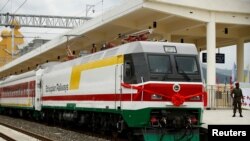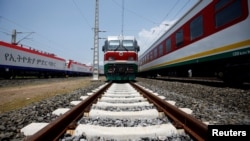Senior Ethiopian and Djibouti officials along with the Chinese diplomatic community in Addis Ababa celebrated on Wednesday the fifth anniversary of service at the Lebu railway station on the outskirts of the Ethiopian capital.
Ethiopia's Finance Minister, Ahmed Shide described the project as a “really transformative infrastructure, which is playing a very significant role,” and said “the Addis Ababa-Djibouti railway line is an example of the ever-flourishing Sino-African relations.”
“The sino-African partnership has passed the test of time, demonstrated its resilience, and marks a brighter and strong future,” he said adding that “the railway is a massive mega infrastructure that is crossing many cities, many regions within Ethiopia and connecting Ethiopia to Djibouti.”
“All these linkages of extension to port facilities, to oil depots, to industrial parks, to logistics parks, is very vital to the development of the entire corridor from Addis Ababa to Djibouti.”
Ethiopia's State Minister of Transport and Logistics Denge Boru extolled the significance of the project for both East African nations.
“The railway mutually benefits the two sisterly countries in promoting regional economic and social integration, facilitating trade and industrial development, and bringing employment and entrepreneurial opportunities for citizens of both countries,” Boru said.
Since it began in 2018, officials say the Chinese-built project, has seen the number of passengers grow, with revenue maintaining an average annual growth rate of over 35%, an example of high-quality cooperation within the Belt and Road Initiative.
A patron named Filimon, who runs an Ethiopian import-export company, switched his company's freight from highway to rail transportation when the railway began commercial operation. Filimon said he has been impressed by the efficiency and convenience brought by the railway.
“There are so many obstacles of the route and the trucks have some delays to arrive here, five, six days. By train, there are only one and a half days to arrive. They are having more costs by truck and this is minimized by train, their half cost,” he said.
Construction of the 752.7- km railway, with a designed speed limit of 120 km per hour, was undertaken by China Rail Engineering Corporation (CREC), and the China Civil Engineering Construction Corporation (CCECC). It is the first trans-boundary railway in African, and was officially put into commercial operation on Jan. 1, 2018.
“The Ethio-Djibouti Railway is also the first electrified railway overseas covering the whole industrial chain that has played an important role in the economic and social development of Ethiopia and Djibouti,” said Liu Weimin, chairman of CCECC.
The railway has handled a total of 1,802 passenger train runs, with 530,000 passenger trips since its became operation, officials said, adding that the railway achieved a total operating revenue of about $140.7 million.
Some information in this report came from Xinhua China state news agency.





